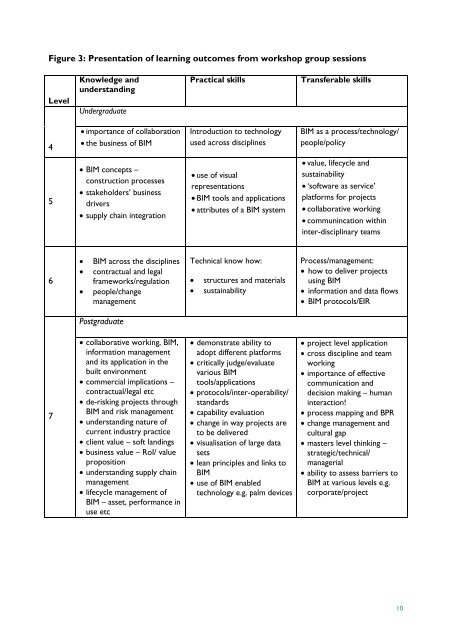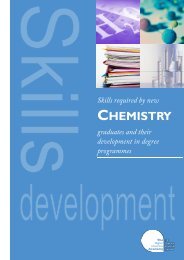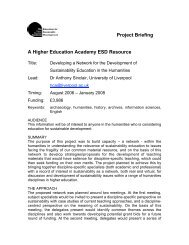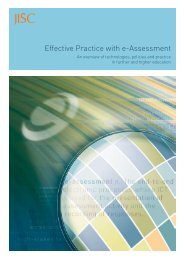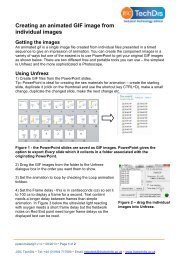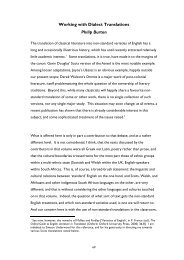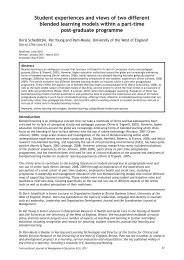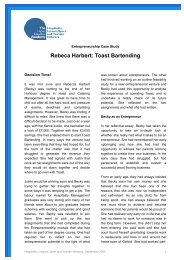Embedding Building Information Modelling (BIM) within the taught ...
Embedding Building Information Modelling (BIM) within the taught ...
Embedding Building Information Modelling (BIM) within the taught ...
Create successful ePaper yourself
Turn your PDF publications into a flip-book with our unique Google optimized e-Paper software.
Figure 3: Presentation of learning outcomes from workshop group sessions<br />
Level<br />
Knowledge and<br />
understanding<br />
Undergraduate<br />
Practical skills<br />
Transferable skills<br />
4<br />
importance of collaboration<br />
<strong>the</strong> business of <strong>BIM</strong><br />
Introduction to technology<br />
used across disciplines<br />
<strong>BIM</strong> as a process/technology/<br />
people/policy<br />
5<br />
<strong>BIM</strong> concepts –<br />
construction processes<br />
stakeholders’ business<br />
drivers<br />
supply chain integration<br />
use of visual<br />
representations<br />
<strong>BIM</strong> tools and applications<br />
attributes of a <strong>BIM</strong> system<br />
value, lifecycle and<br />
sustainability<br />
‘software as service’<br />
platforms for projects<br />
collaborative working<br />
communincation <strong>within</strong><br />
inter-disciplinary teams<br />
6<br />
<br />
<br />
<br />
<strong>BIM</strong> across <strong>the</strong> disciplines<br />
contractual and legal<br />
frameworks/regulation<br />
people/change<br />
management<br />
Technical know how:<br />
structures and materials<br />
sustainability<br />
Process/management:<br />
how to deliver projects<br />
using <strong>BIM</strong><br />
information and data flows<br />
<strong>BIM</strong> protocols/EIR<br />
Postgraduate<br />
7<br />
collaborative working, <strong>BIM</strong>,<br />
information management<br />
and its application in <strong>the</strong><br />
built environment<br />
commercial implications –<br />
contractual/legal etc<br />
de-risking projects through<br />
<strong>BIM</strong> and risk management<br />
understanding nature of<br />
current industry practice<br />
client value – soft landings<br />
business value – RoI/ value<br />
proposition<br />
understanding supply chain<br />
management<br />
lifecycle management of<br />
<strong>BIM</strong> – asset, performance in<br />
use etc<br />
demonstrate ability to<br />
adopt different platforms<br />
critically judge/evaluate<br />
various <strong>BIM</strong><br />
tools/applications<br />
protocols/inter-operability/<br />
standards<br />
capability evaluation<br />
change in way projects are<br />
to be delivered<br />
visualisation of large data<br />
sets<br />
lean principles and links to<br />
<strong>BIM</strong><br />
use of <strong>BIM</strong> enabled<br />
technology e.g. palm devices<br />
project level application<br />
cross discipline and team<br />
working<br />
importance of effective<br />
communication and<br />
decision making – human<br />
interaction!<br />
process mapping and BPR<br />
change management and<br />
cultural gap<br />
masters level thinking –<br />
strategic/technical/<br />
managerial<br />
ability to assess barriers to<br />
<strong>BIM</strong> at various levels e.g.<br />
corporate/project<br />
10


